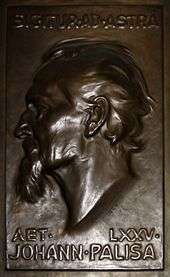Johann Palisa
| Johann Palisa | |
|---|---|
 | |
| Born |
December 6, 1848 Troppau |
| Died | May 2, 1925 (aged 76) |
| Nationality | Austrian |
| Fields | astronomy |
| Institutions | University of Vienna |
| Known for | asteroids |
| Notable awards |
Lalande Prize, 1876 Valz Prize, 1906 |
Johann Palisa (December 6, 1848 – May 2, 1925) was an Austrian astronomer, born in Troppau in Austrian Silesia (now in the Czech Republic).[1]
He was a prolific discoverer of asteroids, discovering 122 in all, from 136 Austria in 1874 to 1073 Gellivara in 1923. Some of his notable discoveries include 153 Hilda, 216 Kleopatra, 243 Ida, 253 Mathilde, 324 Bamberga, and the Amor asteroid 719 Albert.
He was awarded the Valz Prize from the French Academy of Sciences in 1906.[2] The Phocaea main-belt asteroid 914 Palisana, discovered by Max Wolf in 1919, and the lunar crater Palisa were named in his honour.[3]
Early work

From 1866 to 1870, Palisa studied mathematics and astronomy at the University of Vienna; however, he did not graduate until 1884. Despite this, by 1870 he was an assistant at the University's observatory, and a year later gained a position at the observatory in Geneva. A few years later, in 1872, at the age of 24, Palisa became the director of the Austrian Naval Observatory in Pula. While at Pula, he discovered his first asteroid, 136 Austria, on March 18, 1874. Along with this, he discovered twenty-seven minor planets and one comet. During his stay in Pula he used a small six-inch refractor telescope to aid in his research.[1]
Discoveries
_mathilde_crop.jpg)
Between 1874 and 1923 Palisa discovered 122 asteroids ranging from 136 Austria to 1073 Gellivara and the much later numbered Mars-crosser 14309 Defoy, respectively (see table below).[4] He worked from Pola and Vienna. He also discovered the parabolic comet C/1879 Q1 in the year 1879.[1][5]
One of his discoveries was 253 Mathilde, which was visited by the spacecraft NEAR Shoemaker on June 27, 1997. The robotic probe passed within 1200 km of Mathilde at 12:56 UT at 9.93 km/s, returning imaging and other instrument data including over 500 images which covered 60% of Mathilde's surface.[6]
List of discovered asteroids
|
|
| ||||||||||||||||||||||||||||||||||||||||||||||||||||||||||||||||||||||||||||||||||||||||||||||||||||||||||||||||||||||||||||||||||||||||||||||||||||||||||||||||||||||||||||||||||||||||||||||||||||||||||||||||||||||||||||||||||||||||||||||||||||||||||
References
- 1 2 3 Herbert Raab. "Johann Palisa, the most successful visual discoverer of asteroids" (PDF). Astrometrica. Retrieved 3 July 2016.
- ↑ Lockyer, Sir Norman (January 3, 1907). "Prizes Awarded and Proposed by the Paris Academy of Sciences". Nature. 75 (1940): 231. Bibcode:1907Natur..75R.231.. doi:10.1038/075231b0.
- ↑ Schmadel, Lutz D. (2007). Dictionary of Minor Planet Names – (914) Palisana. Springer Berlin Heidelberg. p. 82. ISBN 978-3-540-00238-3. Retrieved 3 July 2016.
- ↑ "Minor Planet Discoverers (by number)". Minor Planet Center. 23 May 2016. Retrieved 28 June 2016.
- ↑ "JPL Small-Body Database Browser: C/1879 Q1 (Palisa)". Jet Propulsion Laboratory. Retrieved 3 July 2016.
- ↑ Williams, David R. (December 18, 2001). "NEAR Flyby of Asteroid 253 Mathilde". NASA. Retrieved 2006-08-10.
External links
Obituaries
- von Hepperger, J. (November 1925). "Anzeige des Todes von Johann Palisa". Astronomische Nachrichten (in German). 225 (7): 125–127. Bibcode:1925AN....225..125V. doi:10.1002/asna.19252250706.